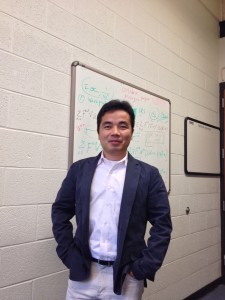 As the College of Engineering welcomes several new members to its faculty this fall, the Department of Aerospace Engineering gains professors who intend to build on Iowa State’s growing research program. Liming Xiong has big plans for the university, including integrating materials research into the aerospace engineering discipline.
As the College of Engineering welcomes several new members to its faculty this fall, the Department of Aerospace Engineering gains professors who intend to build on Iowa State’s growing research program. Liming Xiong has big plans for the university, including integrating materials research into the aerospace engineering discipline.
After spending many years working on materials research, Xiong is excited to work with new colleagues in the aerospace engineering department and develop his own lab for multiscale microstructure materials design.
The three research interests he’s focused on are computational mechanics of materials, multiscale modeling of materials and multifunctional materials with microstructures.
He’ll continue to do similar work here that’s motivated by the Materials Genome Initiative (MGI) developed in 2011 by President Obama. The initiative was launched to help businesses discover, improve and install new materials twice as fast as what has been done in the past.
Xiong said there are three components to MGI: development of a multiscale simulation tool, development of an experimental tool and data management.
“The multiscale simulation tool I’m working on will meet the challenge of the discovery and verification of advanced materials.”
He explained that one of the key challenges in both MGI and aerospace engineering is the slow development and installation of new materials in space—several decades, in many cases.
“Inserting new materials into aerospace vehicle designs typically requires more than 20 years and $400 million,” he said. It takes that much time and money to collect enough data to make designers confident in the structure-property relationships in the insertions.
He uses the Boeing Company as an example of this challenge. “It takes about 50 years to increase the percentage of the execution of a composite from one percent to 50 percent—from a Boeing 747 to a Boeing 787,” he explained. A blogger wrote about the transformation on a site called Material Strategies.
“To accelerate inserting new materials into aerospace structures, one possible strategic plan is the multiscale modeling materials,” he added. “My work can speed up such a pursuit while reducing the cost.”
That cost reduction comes from the method’s capability to predict the behavior of materials from their chemical composition and microstructure. It also involves designing materials for optimized properties, such as high strength and toughness or lightness in weight.
Xiong’s research builds on his foundation as an engineer. He began his studies in 2001 in China—where he’s originally from—earning a bachelor’s degree in engineering mechanics and a master’s in solid mechanics.
Continuing his education in the U.S., he received a master’s degree in solid mechanics and materials science from the George Washington University in 2006 and a Ph.D. in mechanical engineering from the University of Florida in 2011.
Xiong will teach a course called Flight Structure Analysis during his first semester at Iowa State.